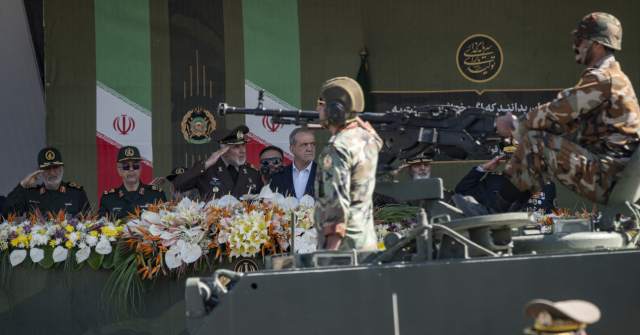Israel seems poised to launch a military strike against Iran, according to officials from the U.S. and Europe. This escalation could trigger widespread conflict in the Middle East and jeopardize the Trump administration’s diplomatic initiatives aimed at limiting Iran’s nuclear ambitions.
As reported by the New York Times, the potential for an Israeli attack and the threat of strong Iranian retaliation prompted Washington to evacuate diplomats from Iraq and allow the families of U.S. military personnel in the Middle East to leave voluntarily.
While the specifics of Israel’s planned operation remain unclear, tensions have surged following months of Israeli Prime Minister Benjamin Netanyahu urging President Trump to capitalize on Iran’s perceived “vulnerability” to authorize military action.
Trump had previously declined an Israeli request for a military strike, emphasizing his preference for negotiating a new nuclear agreement to prevent Iranian nuclear development. Just two weeks ago, he advised Netanyahu against aggressive moves while talks were underway.
However, officials note that Trump recently seems less hopeful. The Iranian supreme leader’s dismissal of a proposal to reduce uranium enrichment has added to the pessimism in the White House.
Netanyahu has almost initiated military action against Iran before, backing off at the last moment. The current situation, however, suggests a shift in that pattern.
The announcement of the U.S. personnel withdrawal coincided with a warning from a British maritime authority, advising merchant ships navigating through the Persian Gulf, Strait of Hormuz, and Gulf of Oman to exercise caution due to “escalated tensions that could escalate into military conflict.”
An Iranian official stated that Iran has developed an immediate response plan, including launching hundreds of ballistic missiles towards Israel. A similar missile strike in October 2024 resulted in limited damage due to U.S. intervention.
Trump and Netanyahu had a phone conversation on Monday, details of which remain undisclosed. This followed a Sunday meeting between the president and his national security team at Camp David.
Iran’s defense minister, Gen. Aziz Nasserzadeh, warned that in the event of conflict, the U.S. would incur significant losses: “America will have to pull out of the region. All its military bases are within our reach, and we will attack without hesitation,” he stated.
Iranian officials also reacted strongly to remarks from General Michael Kurila, head of U.S. Central Command (CENTCOM), who testified to Congress that he had presented Trump with a “wide range of options” for a potential strike on Iran. His scheduled testimony in the Senate was postponed without explanation.
This situation unfolds alongside discussions at the International Atomic Energy Agency (IAEA) board in Vienna, where the U.S., Britain, France, and Germany submitted a resolution condemning Iran’s advancements in its nuclear program and its violations of the 2015 agreement. A vote is anticipated on Thursday.
If passed, the resolution could trigger the reimposition of UN sanctions through a “snapback” mechanism. Iran has cautioned against potential strong reactions, with Foreign Minister Abbas Araghchi stating: “This condemnation will provoke a swift response.”
The Trump administration had unilaterally exited the agreement in 2018, and Iran argues that this legitimizes its withdrawal from restrictions. However, European nations maintain that the agreement is still valid and sanctions can be reinstated.
Meanwhile, no negotiations have been cancelled. U.S. and Iranian negotiators were set to meet in Oman on Sunday, even though Trump stated on Monday that Iran has taken an “unacceptable stance.” Special envoy Steve Whitcoff is reportedly still planning to attend.
The U.S. State Department has not disclosed the number of personnel being withdrawn, but the Associated Press reported non-essential staff are being recalled from the Baghdad embassy, with approval granted for staff and their families to leave the embassies in Bahrain and Kuwait.
The withdrawal mainly involves Navy and Marine families in Bahrain, which hosts a major U.S. naval base.
Analysts highlight that Iran’s nuclear program has significantly advanced since 2018, now believed to have the capability to produce materials for up to ten nuclear weapons. Building an operational weapon would still take several additional months, but many Israeli officials believe the situation has surpassed the threshold of tolerability.
In Israel, there is a consensus that now may be the opportune moment to address the issue, as Hamas and Hezbollah—Iran’s proxy groups—have been weakened, and recent Israeli airstrikes have impaired Iran’s air defense systems.
Conversely, other analysts argue that Iran is quickly rebuilding its defense capabilities, indicating that Israel’s window for action may soon close. It’s also uncertain if Israel could deliver a decisive strike on Iran’s nuclear program without U.S. support.
Oil prices surged on Wednesday, with U.S. crude exceeding $68 a barrel—the highest since early April when Trump imposed tariffs on nearly all U.S. trading partners. Potential military conflicts or harsher sanctions against Iran could disrupt global markets.
The USS Carl Vinson, an aircraft carrier stationed in the Arabian Sea, has been operational for weeks, equipped with over 60 aircraft, including F-35s. A Navy source indicated there are no plans for its movement at this time.
The U.S. also maintains a significant presence of fighter and bomber aircraft in the region, previously utilized to intercept Iranian missiles aimed at Israel in 2024.
As diplomatic efforts wane and military forces remain on high alert, the pivotal question looms: will Israel ignite a new war in the Middle East, and how will the global community respond?
Ask me anything
Explore related questions

















